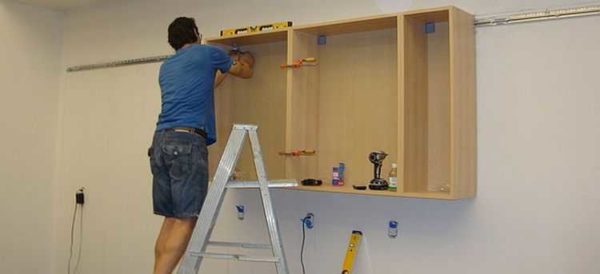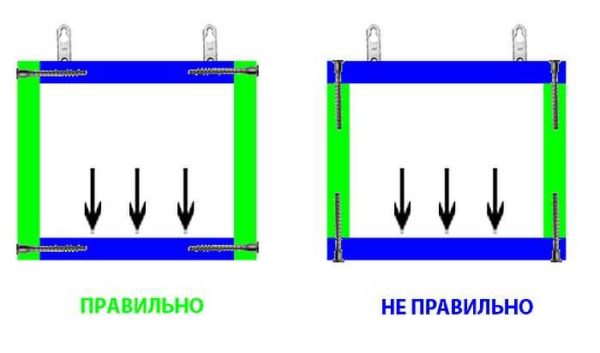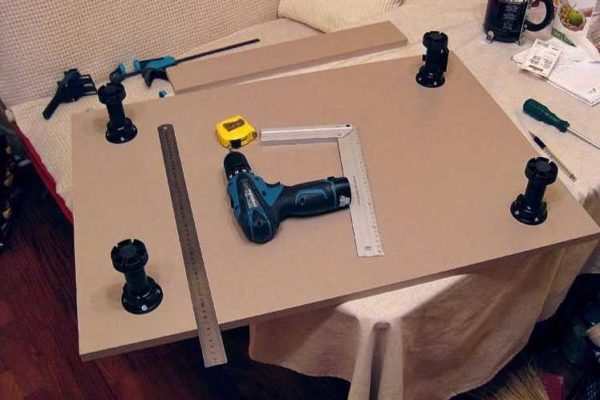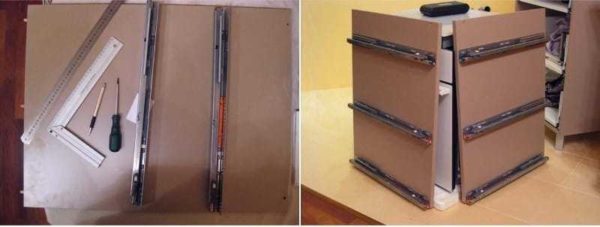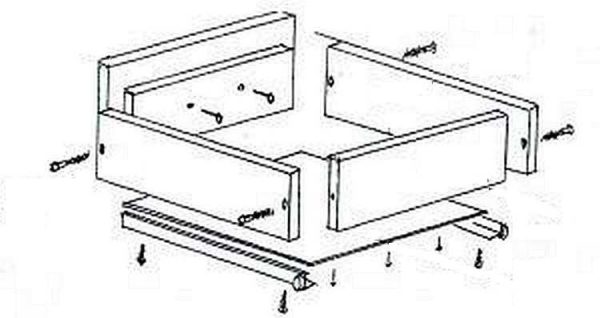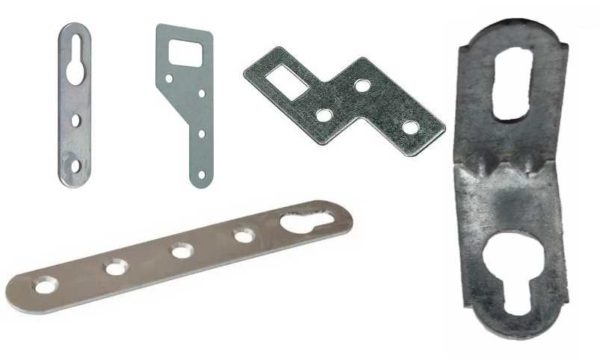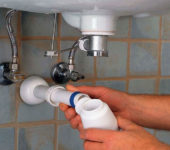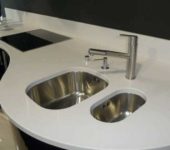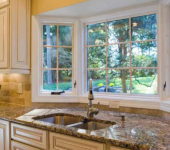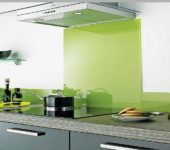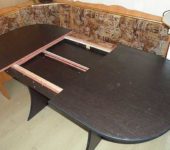Kitchen assembly instructions
Kitchen furniture from a workshop or factory comes disassembled. You can entrust the assembly to specialists, but few are capable of making a better owner. Only those who work "as for themselves", and such are extremely rare. Therefore, many people prefer to assemble a kitchen set on their own. It will take a decent amount of time, but the quality will be great.
The content of the article
- 1 Tools
- 2 Assembly of kitchen cabinets
- 3 How to hang cabinets in the kitchen
- 4 How to install a kitchen set
- 5 How to install a countertop on a kitchen set
- 6 Kitchen furniture assembly video
Tools
Before assembling a kitchen set, you need to assemble a tool for work. Simple tools are required, but they make things much faster and easier.
- Screwdriver or a set of screwdrivers.
- Drill with drills of different diameters.
- If the walls are concrete or brick you need a perforator - drill holes for the fasteners of the upper cabinets.
- A hacksaw or jigsaw may be required.
- Allen key - for fasteners (can be included in the set).
- Hammer, ruler, square, bubble level.
It's a good idea to have a plane builder or laser level. With it, the display of cabinets in the same plane is much easier.
Assembly of kitchen cabinets
The disassembled kitchen set is a set of boards of different sizes, a number of fittings and a set of fasteners. From all this it is necessary to assemble cabinets. Usually there are wall-mounted and floor-standing ones. How to assemble a kitchen set, in what order - the choice is yours. It is more convenient for some craftsmen to collect them in pairs - the upper one, then the lower one and so install. But there are two other ways: first, collect all the upper ones, hang them on the wall, then - all the lower ones. They do it and vice versa - collect and install the lower ones, then the upper ones. In general, any method is correct, do it as you like.
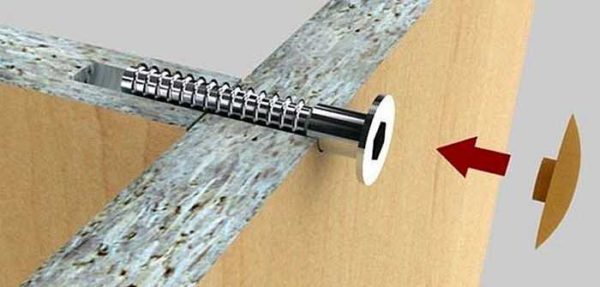
Correct installation of the confirmation - in the middle Chipboard
Assembly of wall cabinets
In any case, we begin to assemble the cabinets. A conventional wall cabinet consists of two side panels, a top, a bottom, a back wall made of MDF and two doors - a facade. The assembly order is as follows:
Installation of hinges
The facades (doors) are finally hung after they have assembled and put everything in place, but they put the hinges from the very beginning. They are mortise (considered more reliable) and overhead.
The attachment points are marked on the sidewall and door with holes. We fold the sidewall and the door on a flat surface (table or floor) close to each other, aligning the marks. We put the hinges in place (included). Fasten first to the sidewall, then to the facade. In this case, the door turns out to be slightly lower in level than the sidewall. Under it, put a block of a suitable size or a rolled rag so that it is on the same level, then we fasten the loop.
We disassemble the hinge itself (it consists of two detachable hinges, which are connected with a screw. We unscrew this screw, set the doors aside, and work on the sidewalls further.
Assembling the case
We attach the top and bottom to the sides. They are attached to confirmations - special furniture fasteners that come with the kit, with a hexagon head. If there is a corresponding bit, we put it on the screwdriver, if not, we work with a hand key.
The locations for installing the confirmations are marked on the outer part of the sidewalls.We fold the sidewall and the upper part, install the fasteners, then the bottom, and then the second sidewall.
We turn it face down, lay down and align the laminated fiberboard sheet, which serves as the back wall. It is nailed down with small nails or staples from construction stapler... First, they are nailed in the corners, carefully leveling the edges, then in the middle of each side and then, dividing each section in half. As a result, the installation frequency is 1 nail / staple for about 10 cm.
Installation of corners or hinges, shelf holders
The hinges on which the wall-mounted kitchen cabinets are hung are different, they are installed in different ways. We'll talk more about them below. Shelf holders are also different in material and shape, but they are attached basically the same way - in the holes in the wall. Holes are drilled under them in the sidewalls. Sometimes we install plastic chopiks (small hollow plastic cylinders) in them, hammer them in by knocking lightly with a furniture hammer, then we put stops for the shelves in them. But most of the metal stops (and these are probably needed in kitchen cabinets) are simply placed in the hole.
Actually, you know how to assemble a hinged kitchen cabinet. For a visual demonstration, watch the video. Floor cabinets with shelves without drawers are also assembled, only first the legs are installed on the bottom and the upper part is a tabletop, and it is common to all cabinets and is placed after all floor cabinets are installed and fastened.
Assembling the cabinet with drawers
We continue to assemble the kitchen set with our own hands. Now the most difficult moment is the drawer units. The general order of work is as follows: we install the hinges, bottom and back wall. The top-table top is placed after all the cabinets are assembled and fastened together with ties. There are also special features - drawers must be attached to the sidewalls. Go.
Installing the legs
Before assembling the kitchen set, the legs are installed further on the bottom. You can install the legs after the frame is assembled, but it is not very easy to turn a heavy bedside table. In any case, it is best if they are adjustable - the floor is not always perfectly flat. With adjustable legs, it is possible to position them so that the load is redistributed to all legs. On small cabinets - up to 80 cm long - they put 4 stops, more than 80 cm 6 anchor points are needed.
If there is a partition in the cabinet, place the legs under it. If there is no partition - in the middle. 5-8 cm recede from the edges, screw on self-tapping screws 15 mm long (with a chipboard thickness of 18 mm). Most finished furniture also has countersinks under the legs - small diameter holes. Align the slots in the legs with the holes, install the screws.
Installation of rails and assembly for boxes
On the sidewalls of the lower cabinets there are markings for the installation of guides (they are included in the kit). For their fastening, a Euro screw M6 * 13 is used. We install the required number of guides on both sides.
The boxes are assembled with 4 * 45 screws. The guides are installed first. Depending on the design, they can be mounted on the walls of the box or on the lower edge of the sidewall. If there are markings (holes) on the wall, then they are placed on the sidewalls. If not - to the butt. Check your assembly instructions to be sure. There should be an installation process in the pictures.
After the guides are connected, the sidewalls are connected to the rear wall, then the front wall is installed, then the bottom. Before installing the bottom, check the diagonals. They must match up to a millimeter. The bottom is secured with nails or staples.
Assembling the case
The assembly of the case is already familiar: we attach the lid to the sides, then the lower part with the legs.We put the cabinet in place, twist the legs so that the top cover is at the desired height and is horizontal. We check the horizon using a bubble or laser level. Then we install the covers.
Features of the assembly of the corner cabinet
The main feature is that in budget kitchen sets, the bottom consists of two parts (to reduce the cost). If this cabinet provides for the installation of a sink, the back wall is almost absent, but there are several collets-ties that add rigidity to the structure. Otherwise, everything is the same as when assembling a conventional cabinet with doors.
How to hang cabinets in the kitchen
Even before assembling the kitchen set, it is necessary to purchase canopies and intersectional furniture ties for attaching wall cabinets. Let's start with awnings, they are of different types, so let's talk about them.
You already know how to assemble a kitchen set, you need to figure out how to install it in place. Wall cabinets of the kitchen set are mounted on the wall. They are fastened with furniture awnings. They come in the form of metal plates with holes for fasteners, but there are also more complex designs. Cheaper ones are ordinary metal plates. They can be of different shapes, made of ordinary or galvanized steel.
Simple awnings
The most common option (top left) is a plate with two small holes for fasteners and one large one (a hook or a head of a screw installed in the wall is inserted into it). It is installed on the end of the sidewalls - on the right and left. With a heavy load, this type of canopy can break off, since the fasteners are at a short distance from each other and chipboard can fall apart. A more reliable option is from the bottom - more fasteners, but there is still a risk.
The other two types of furniture awnings are more reliable, since one of the screws will also be installed in the cabinet lid, that is, the load will be distributed over a larger area.
The corners showed themselves well. One edge of this canopy is secured through a cover. A through hole is made, a bolt with a washer is installed at the bottom, tightened with a nut on top (also with a washer). They are installed at a distance of 5-10 cm from the edge, if a large load is expected, three or four pieces can be put, which is impossible with previous models.
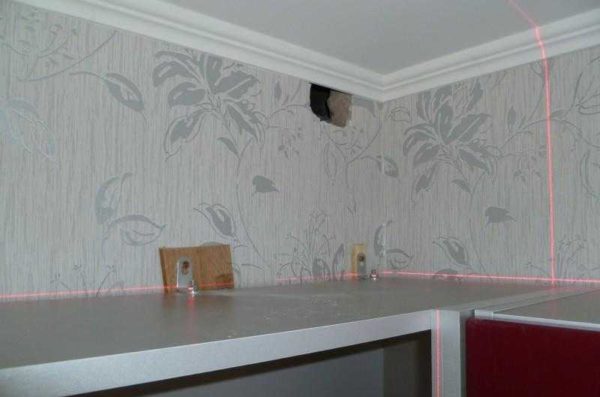
Kitchen cabinets are hung on corners with pads - to compensate for the difference in apron thickness
The common drawback of all these mounts is that they are not adjustable. As they hung, so be it. There is no way to move from the wall or to the wall. If kitchen apron protrudes above the plane. walls, you have to mount a bar on the wall or select a lining for each fastener (a piece of plywood, a piece of wood, etc.). The second drawback is that a separate hook or dowel must be installed under each canopy. Not very comfortable.
Adjustable
A more complex and expensive canopy consists of a plastic body, a metal canopy and an adjustment system that allows you to move it forward / backward and up / down. These awnings are attached to the side walls of the cabinet from the inside; a small hole is cut in the back wall. Paired with these awnings is a mounting rail or strip. It is attached to the wall, hooks of awnings cling to its upper ledge. It is very easy to install and remove wall cabinets with this fastening system, and they have sufficient "carrying capacity" of 20-50 kg per canopy (depending on the model and manufacturer).
How to install a kitchen set
As already mentioned, the order of installation of the lockers is arbitrary. You can first hang the upper ones then the lower ones or vice versa. It does not matter. The order of installation is important: they always start from the corner. How flat this first cabinet will be exposed depends on how easy the further installation will go.
The mounting height of the wall cabinets depends on the height of the “users”, but not lower than 45 cm from the table top level.When hanging cabinets on the wall, mark a horizontal line. It can be drawn using a bubble or water level, but the easiest way is to unfold the plane at the required height using a level or plane builder. Along this line, the upper edge of the mounting plate is installed or the cabinets are aligned when mounted on ordinary awnings.
The task is both simple and difficult at the same time - to set the cabinets so that they are on the same level, and their walls are vertical and horizontal. In this case, there will be no problems during operation.
Since the kitchen furniture consists of separate cabinets, they are fastened together. There are two options - to install, then fasten, or first fasten, then hang. The second option is possible if there are helpers - even hanging two fastened cabinets alone is not an easy task.
The lockers are fastened together with the help of intersection ties. They are of different diameters and different lengths - under laminated chipboard of different thicknesses. One wall requires at least two ties. They are placed in the area of the loops - slightly lower or slightly higher. Two cabinets are exposed in the same plane, their walls are fastened with clamps, a through hole is made - according to the diameter of the tie into which the fasteners are installed, tightened with a screwdriver or screwdriver.
How to install a countertop on a kitchen set
To assemble the kitchen set completely, it is necessary to install the countertop. It is fixed after the cabinets are pulled together. Steel corners are installed on the walls, with which the tabletop is fixed. See the video for subtleties in processing the ends and cutouts for the sink.
How to process slices of laminated chipboard worktops, see the following video. It is useful for those who want to assemble a kitchen set according to all the rules.
Kitchen furniture assembly video

